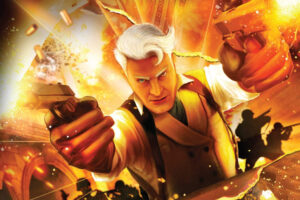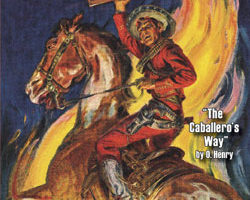 In learning more about the pulp hero as a phenomenon, I frequently saw mention of The Gray Seal. First published in 1914, he was popular enough that his works were quickly reprinted in book form, and a movie serial was done. But there were only five novels put out over 20-year period! While there are earlier editions out there, we are finally getting them reprinted in uniform series, along with a recent sixth novel. Canadian author Frank L. Packard (1877-1942) created him.
In learning more about the pulp hero as a phenomenon, I frequently saw mention of The Gray Seal. First published in 1914, he was popular enough that his works were quickly reprinted in book form, and a movie serial was done. But there were only five novels put out over 20-year period! While there are earlier editions out there, we are finally getting them reprinted in uniform series, along with a recent sixth novel. Canadian author Frank L. Packard (1877-1942) created him.
The Gray Seal is really Jimmie Dale. At first glance, he follows the model of the rich playboy out for thrills, stealing from the unjustly rich to give to the poor that so many early pulp heroes (especially those from Johnston McCulley) followed from. However, while Dale broke into homes and safes, he never stole anything, but left a gray diamond paper seal behind. Hence the name. He wears a mask and slouch hat, along with a belt of burglary tools — a sort of “utility belt.”
But about a year before the first novel, he is discovered and blackmailed by a mysterious woman named Tocsin (French for “alarm bell”) to use his skills to help people and then to battle certain criminal elements, in particular the “Crime Club”, which controls all crime in New York. He moves from doing it as a lark to actually becoming heroic.
Jimmie maintains a secret hideout, his Santuary, in the slums where he has disguises hidden, and takes on an identity to allow him to move unnoticed in the underworld: “Larry the Bat,” a dope fiend. However at the end of the first book, his hideout is discovered, and this identity is unmasked, so I assume he has to create new ones in the following books.
And, yes, he will eventually meet Tocsin and figure out who she really is and how she is connected to the Crime Club. At the end of the first book they leave for a new life together, only to come back for more adventures.
You see many of the elements that would appeared in characters following him, such as several of McCulley’s characters, including Zorro, and later pulp heroes and comic-book heroes as well: disguises and other identities, acting as a foppish playboy, secret headquarters/sanctum, mask and slouch hat, utility belt, and more. It was interesting seeing him be careful of leaving fingerprints on his gray seals when he applies them. This element was used well in one of the cases he dealt with.
His adventures would be published first in serialized form in several pulp magazines, and then later reprinted in book form:
- The Adventures of Jimmie Dale (1917) in People’s May 1914-March 1915 and June-August 1915
- The Further Adventures of Jimmie Dale (1919) in People’s November 1916-September 1917
- Jimmie Dale and the Phantom Clue (1922) in People’s July 1921-May 1922
- Jimmie Dale and Blue Envelope Murder (1930) in Short Stories June-August 1930
- Jimmie Dale and the Missing Hour (1935) in Detective Fiction Weekly March-April 1935
In looking over these, I was puzzled by the large gap between the third and fourth books. Before creating Jimmie Dale, Packard had written other works, including other series such as Henri Raoul Charlebois in People’s from 1912 to 1913, Mr. Simpson and Hill Division (in Popular from 1911 to 1915). But his output seems less in those later years for some reason. As he’s Canadian, he could have been writing more for publication there.
There was also a movie serial in 1917. In looking around, I don’t see any source for the serial, either on YouTube or from various online sources for serials like the Serial Squadron.
 More recently, Michael Howard has written a new novel, Jimmie Dale, Alias the Gray Seal (2017). It’s actually a prequel, with most of it set before the action in the first novel. He is behind the effort to republished the five original novels in an “authoritative edition” of three volumes. The first one has the first novel, which is quite long, while the next two books will have two novels each.
More recently, Michael Howard has written a new novel, Jimmie Dale, Alias the Gray Seal (2017). It’s actually a prequel, with most of it set before the action in the first novel. He is behind the effort to republished the five original novels in an “authoritative edition” of three volumes. The first one has the first novel, which is quite long, while the next two books will have two novels each.
I have gotten that first volume and read through it. Howard has annotated it, and I assume he’ll do the same with the others. Because it was serialized, it does drag a little, and there is a little bit of repetition. As noted, with the first novel we learn that Jimmie had been the Gray Seal for a few years, but for the past year had done nothing after the Tocsin had “caught” him. Now she sends him into action to help various people, using his identity and skills as the Gray Seal.
For most of the first part of the story we get standalone episodes of him helping people out. However, there is tension, as he has to keep his identity unknown, and he sometimes gets trapped and has to get out of it. In one case, he is forced to stay in the identity of Larry the Bat for awhile. In another a pickpocket grabs his wallet with a letter from Tocsin, and he has to retrieve it to prevent being exposed. In the meantime, he tries to figure out who the Tocsin is. Finally in the second part he goes into action against the Club after he meets her, and learns of her connection to the Club, which turns the story into a bit of a revenge tale. In the end they defeat the Club, prevent Jimmy’s identity from being exposed, and leave for a life together.
However, I do know the next two novels, collected in the next volume, will have their final battles against the Crime Club. Which may explain the gap after the third novel, as this would wrap up their work against the Club. So I guess the final two novels in the last volume will have them deal with other criminals. From the intro, we learn that Packard was working on a sixth Gray Seal novel when he passed. It would be interesting to see Howard use this for a future work, but who knows.
I do look forward to the next volume, which is promised later this year. I’ll be reviewing it and the new one as soon as I can. Check this out as it’s interesting to see the progression and development of the pulp hero here.



